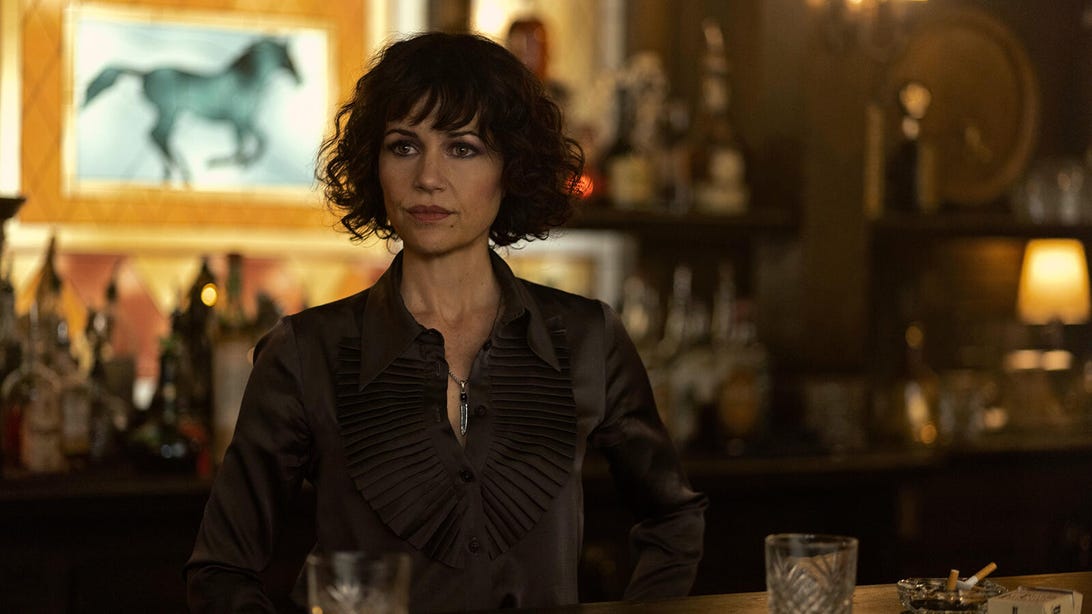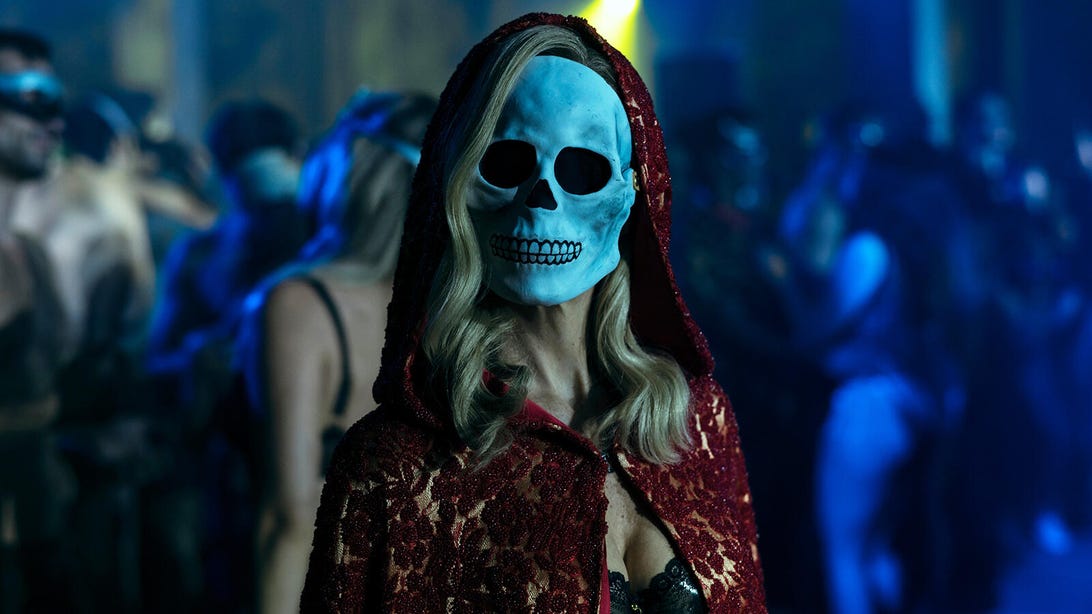Join or Sign In
Sign in to customize your TV listings
By joining TV Guide, you agree to our Terms of Use and acknowledge the data practices in our Privacy Policy.
The Fall of the House of Usher's Carla Gugino Explains How She Crafted One of the Year's Best Horror Performances
Gugino reveals the influences behind the 'patient, observant, and formidable' Verna

Carla Gugino, The Fall of the House of Usher
Eike Schroter/Netflix[Warning: The following interview includes spoilers for The Fall of the House of Usher.]
Carla Gugino's Verna is one of the most intriguing TV characters this year: an omniscient shapeshifter who stalks the background of Mike Flanagan's latest Netflix horror series.
Her fifth collaboration with Flanagan, this role positions Gugino as The Fall of the House of Usher's antagonist — although not necessarily its villain. Verna may kill most of the main characters, but her victims are far from sympathetic. Gugino says this role invited her to examine "big themes like life and death, karma, accountability, self examination, and empathy," as Verna picks off a series of spoiled nepo babies to balance the scales of their ill-gotten wealth.
Riffing on the Sackler family, whose drug company Purdue Pharma is often blamed for America's opioid crisis, Flanagan reimagined Edgar Allan Poe's Usher family as a Succession-like corporate dynasty. They're led by aging CEO Roderick (Bruce Greenwood) and his ruthless sister Willa (Mary McDonnell), who kickstarted their careers by making a devil's deal with Verna. Decades later, Verna returns to collect their debts. Played by regular Flanagan collaborators like Kate Siegel, Rahul Kohli, and Samantha Sloyan, Roderick's offspring arguably get what's coming to them. It's a more satirical style of horror than their work on shows like The Haunting of Hill House, which leaned more toward tragedy and trauma.
In an email interview with TV Guide, Carla Gugino describes Verna as a "non-moralistic" figure who hides in plain sight, standing apart from humanity. She orchestrates each death with a sense of poetic justice, adopting different personas to approach each Usher child. Perhaps we shouldn't be surprised to hear that for research purposes, Gugino rewatched Kind Hearts and Coronets, the 1940s dark comedy where Alec Guinness plays eight separate characters.
For one of the Usher murders, Verna becomes a masked interloper at an elite orgy. For another, she pretends to work at a cat sanctuary. One memorable moment sees her embody an enraged chimpanzee in a medical testing lab — a performance that Gugino developed with help from stunt actor Terry Notary, known for playing motion-capture roles in movies like Planet of the Apes. Each persona is instantly distinct from the others, yet each is still unmistakably Verna, slyly encouraging the Ushers to dig their own graves.
In this spoiler-filled interview, we delved into the gory details of Verna's multifaceted role, covering the creative process behind her multiple personalities, Gugino's relationship with the horror genre, and much more.

Carla Gugino, The Fall of the House of Usher
Eike Schroter/NetflixVerna is an ambitious role: An immortal shapeshifter with a wide variety of different personas. What was the development process like for this character, when Mike Flanagan first came to you with his vision for the show?
Carla Gugino: The development process was thus: Mike would send me each script as soon as it was written, I would devour it, read the Verna parts with great excitement and wonder, "How the hell am I going to pull this off?"
When I finished the last one I was 100 times more exhilarated by the scope of the character and 1000 times more worried about falling flat on my face trying to bring it to life. Once I rolled up my sleeves to differentiate each character and give them different gestures and sometimes accents, it was a fluid collaboration with Mike and his longtime Director of Photography Michael Fimognari, who directed half the episodes.
I would come to Mike with an idea like, "Perhaps the animal shelter worker is from the Midwest. There's something in how you've written her that feels polite on the surface, but there's a whole other conversation happening underneath. She clearly thinks animals are far superior to humans." I worked with Terry Notary on a lot of the physicality as well, which led me to hone in not only on the more primal incarnations — i.e. raven, cat, primate — but he also became an indispensable ally in exploring different centers of gravity for each character and how they interact with the world around them.
Verna adopts human disguises like the bartender or the masked party guest because they resonate with her targets in the Usher family — but we still recognize hints of the "real" Verna underneath. How did you create connections between those personas and Verna's original, supernatural identity?
Gugino: In a weird way the built-in advantage I had is we're not trying to fool the audience into believing it isn't me in the new guise, but rather convince them that this is simply a different iteration of her spirit. To create a golden thread that connects them. Verna's curiosity about human creatures and non-moralistic stance were through-lines. Verna isn't reactive, she's patient, observant, and formidable. She doesn't need to announce any of that, just be it.
Were you inspired by any particular films or characters when working on House of Usher?
Gugino: I rewatched Alec Guinness in Kind Hearts and Coronets and Deborah Kerr in The Life and Death of Colonel Blimp, but mostly because I'm a sucker for Ealing Studios and Powell-Pressburger, so I'll use any excuse to do so. The truth is I suspected all along I'd have to approach this in a totally different way: Verna is a larger than life character that shouldn't be played larger than life because she has always been here before, hiding in plain sight. She can't call attention to herself. She's like Zelig, present in every photograph, always there in key moments in history, while somehow, inconceivably (and I'm saying this in my best Wallace Shawn voice) going completely unnoticed.
You've enjoyed an impressively diverse career on stage and screen. Do you find yourself using different techniques in a project designed to frighten and disturb the audience, or do you approach horror in a similar way to other roles?
Gugino: The requirements are pretty clear in horror; you need to unsettle the audience and scare them. After that it's fair game to be as smart and full of ideas as you want. Mike understands this. Playing Verna allowed me to explore big themes like life and death, karma, accountability, self examination, and empathy.
The approach as an actor is the same as in any genre or medium: How can my character best serve the story? In this case, Verna is both the question and the answer that the audience is trying to discern. She originates the deal and she's here to collect.
I'm sure every viewer has a different favorite among Verna's subplots with the Usher family. Personally, I loved the scene where you play a sex worker impersonating Samantha Sloyan's character, Tamerlane. Did you have a particular favorite persona to film?
Gugino: As Verna, I'm not allowed to play favorites, but a funny anecdote about the sex worker Candy — I gave them all names — she was a New Yorker with a full backstory until hours before we shot the first scene with her, when something about that incarnation wasn't entirely convincing to Mike. So, I turned her into a Brit. It felt right immediately. I would love to explore Candy further as she makes an impactful but quick appearance.
The Fall of the House of Usher is now streaming on Netflix.